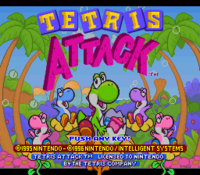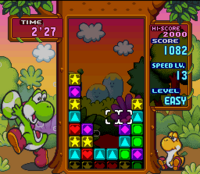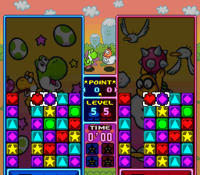Tetris Attack: Difference between revisions
mNo edit summary |
mNo edit summary |
||
| Line 1: | Line 1: | ||
{{Infobox | {{Infobox | ||
|image=[[Image:TAT.jpg|225px]]<br>'''SNES box art.'''<br><br>[[Image:TA_GameBoyCover.jpg|275px]]<br>'''Game Boy box art.''' | |image=[[Image:TAT.jpg|225px]]<br>'''SNES box art.'''<br><br>[[Image:TA_GameBoyCover.jpg|275px]]<br>'''Game Boy box art.''' | ||
| developer = [[Intelligent Systems]] | |developer=[[Intelligent Systems]] | ||
| publisher = [[Nintendo]] | |publisher=[[Nintendo]] | ||
| designer = | |designer= | ||
| engine = | |engine= | ||
| released = '''[[SNES]]:''' <br> [[Image:Flag of USA.png|22px]] August 1996 <br> [[Image:Flag of Japan.png|22px]] November 3, 1996 <br> [[Image:Flag of Europe.png|22px]] November 28, 1996 <ref>[http://www.themushroomkingdom.net/games/ta-snes Date info of Tetris Attack (SNES) from TMK], retrieved 4/1/2008</ref> <br> '''[[Game Boy]]:''' <br> [[Image:Flag of USA.png|22px]] August 1996 <br> [[Image:Flag of Japan.png|22px]] October 26, 1996 <br> [[Image:Flag of Europe.png|22px]] November 28, 1996 | |released='''[[SNES]]:''' <br> [[Image:Flag of USA.png|22px]] August 1996 <br> [[Image:Flag of Japan.png|22px]] November 3, 1996 <br> [[Image:Flag of Europe.png|22px]] November 28, 1996 <ref>[http://www.themushroomkingdom.net/games/ta-snes Date info of Tetris Attack (SNES) from TMK], retrieved 4/1/2008</ref> <br> '''[[Game Boy]]:''' <br> [[Image:Flag of USA.png|22px]] August 1996 <br> [[Image:Flag of Japan.png|22px]] October 26, 1996 <br> [[Image:Flag of Europe.png|22px]] November 28, 1996 | ||
| genre = Puzzle | |genre=Puzzle | ||
| modes = Single player, Multiplayer | |modes=Single player, Multiplayer | ||
| ratings = (K-A) Kids to Adults, (E) Everyone | |ratings=(K-A) Kids to Adults, (E) Everyone | ||
| platforms = [[Super Nintendo Entertainment System]], [[Game Boy]] | |platforms=[[Super Nintendo Entertainment System]], [[Game Boy]] | ||
| media = ROM cartridge (USA/PAL/GB JP), [[Satellaview]] Download (SNES JP) | |media=ROM cartridge (USA/PAL/GB JP), [[Satellaview]] Download (SNES JP) | ||
| input = | |input= | ||
}} | }} | ||
'''''Tetris Attack''''' is a [[Super Nintendo Entertainment System]] and [[Game Boy]] puzzle game, based off the Japanese game ''Panel De Pon''. Despite its name, ''Tetris Attack'' has no relation to the ''[[Wikipedia: Tetris|Tetris]]'' series and was later renamed ''Puzzle League'' when the sequels (such as ''[[Dr. Mario & Puzzle League]]'') came out. | '''''Tetris Attack''''' is a [[Super Nintendo Entertainment System]] and [[Game Boy]] puzzle game, based off the Japanese game ''Panel De Pon''. Despite its name, ''Tetris Attack'' has no relation to the ''[[Wikipedia: Tetris|Tetris]]'' series and was later renamed ''Puzzle League'' when the sequels (such as ''[[Dr. Mario & Puzzle League]]'') came out. | ||
| Line 51: | Line 51: | ||
==References== | ==References== | ||
<references/> | <references/> | ||
{{Yoshi series}} | {{Yoshi series}} | ||
{{SNES}} | {{SNES}} | ||
Revision as of 00:37, November 11, 2009
Template:Infobox Tetris Attack is a Super Nintendo Entertainment System and Game Boy puzzle game, based off the Japanese game Panel De Pon. Despite its name, Tetris Attack has no relation to the Tetris series and was later renamed Puzzle League when the sequels (such as Dr. Mario & Puzzle League) came out.
Gameplay
The title of the game is misleading in that the gameplay is little like Tetris. Instead, square panels rise from the bottom (called the "stack") and the job of the player is to line up three or more matching panels either horizontally or vertically as the stack rises. The player controls the panels using a rectangular cursor on the screen which the player uses to switch the selected panels back and forth. Extra points are given for combinations of more than three. If the stack touches the top of the playing field while rising, the game is over.
Single Player Mode
In this game the players only opponent is him/herself. The game can be endless, provided the player is fast enough. This mode is great for practice and improving the player's skills. When they begin the game the player sets a starting level and chooses an ally; as the gamer plays, the game gets harder by gradually increasing the speed at which the stack rises. The object is for the player to play as long as they can before the stack begins rising faster than they can play, because if it touches the top, the game is over. The player will receive points for clearing panels, the player will receive more points for clearing more panels at once, using either combos, chains, or skill chains (see below).
Stage Clear
This mode is just like the Endless mode (see above) except the player is given a time limit and must clear all the panels above a "clear line" drawn in the stack. The line is not visible a the beginning of the game and is only visible when the player has cleared enough panels for the stack to rise enough. If the player does not clear all the panels before the time is up or if the stack touches the top, he/she will lose.
Time Trial
The time trial mode is also similar to the Endless mode, except the player is given a time limit of two minutes and the object is to score as many points as possible before time is up.
Puzzle
In the puzzle mode, the player is given a number of panels on the screen that they must clear all of them with only a limited number of switches by the cursor. There is no time limit. The player plays eight rounds with each character from the game before moving on to another character until they reach Bowser. At the end of each round the player is given a password which they can use to come back to their game at a later time.
VS
Single player VS is a game where the player can battle the computer in a fight. To free the player's allies from a spell cast by Kamek Koopa. One by one, the player and Yoshi must break the spell over each of the player's allies by battling and defeating them by dropping garbage blocks, which resemble the Evil Ceiling from Wario's Woods, on their stack. Each battle gets successively more difficult and as the player progress and free their allies the player can use them in battle as well. Eventually the player will reaches Hookbill the Koopa, battle Kamek and Naval Piranha. In the hard mode the player will actually battle Bowser at the end and if they win, they will be presented with the game credits and then a cheat code to play in a secret extra-hard battle mode.
Characters
While Mario does not make a direct appearance in this game, Yoshi however plays a starring role as an ally and a tutor to teach the player the game. A multitude of other characters from the Mushroom Kingdom appear in the game as well, some as allies and some as enemies. Allies include Baby Yoshi, Lakitu, Shy Guy, Bumpty (SNES version only), Poochy, Flutter, Gargantua Blargg, Lunge Fish, Raphael the Raven, and Prince Froggy. Enemies include Bowser, Kamek Koopa, Hookbill the Koopa and Naval Piranha.
Other Release Formats
The Japanese version of Tetris Attack, titled ヨッシーのパネポン (Yoshi no Panepon) was released on the Satellaview. This version was a Japanese localization of the rebranded Panel De Pon with Yoshi characters. There was also an option in the menus to play the game with the characters and story dialog in English, but the menus would stay in Japanese.
The Game Boy version was also released in Japan under the same name, as a standard GB ROM cartridge.
Reception
The game was placed 17th in the 100th issue of Nintendo Power's "100 best Nintendo games of all time" in 1997.[1] Template:Sectionstub
References
- ^ http://www.gamekult.com/communaute/forum/voirmessage.html?foid=13000909, retrieved 6/4/2009
| Game Boy games | |
|---|---|
| Super Mario franchise | Alleyway (1989) • Baseball (1989) • Super Mario Land (1989) • Golf (1989) • Dr. Mario (1990) • Super Mario Land 2: 6 Golden Coins (1992) • Donkey Kong (1994) • Mario's Picross (1995) • Picross 2 (1996) |
| Donkey Kong franchise | Donkey Kong (1994) • Donkey Kong Land (1995) • Donkey Kong Land 2 (1996) • Donkey Kong Land III (1997) |
| Yoshi franchise | Yoshi (1991) • Yoshi's Cookie (1992) • Tetris Attack (1996) |
| Wario franchise | Wario Land: Super Mario Land 3 (1994) • Wario Blast: Featuring Bomberman! (1994) • Wario Land II (1998) |
| Miscellaneous | Tetris (1989) • The Legend of Zelda: Link's Awakening (1993) • Game & Watch Gallery (1997) • Game & Watch Gallery 2 (1997) |



